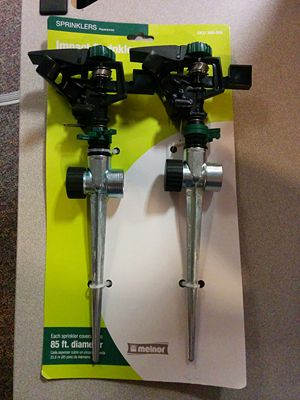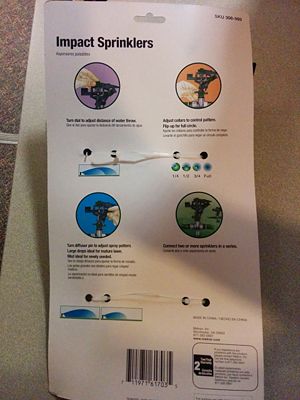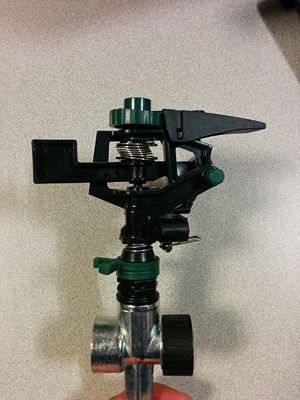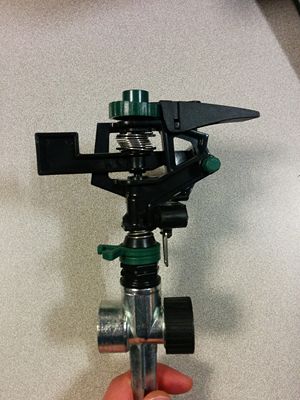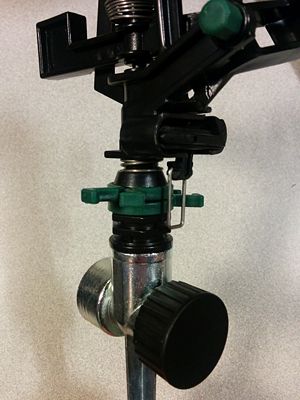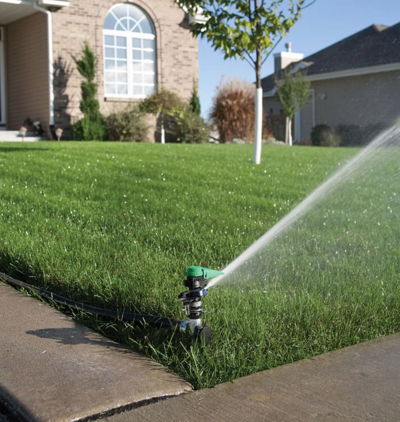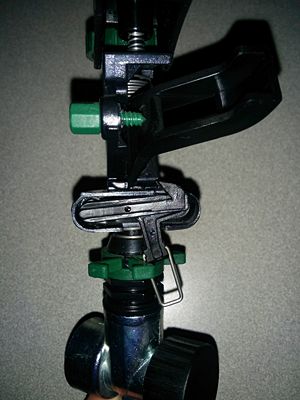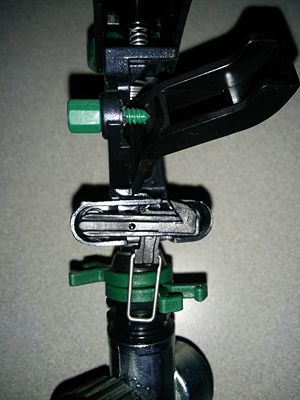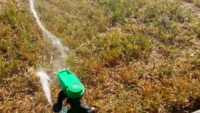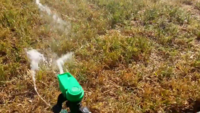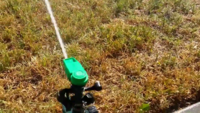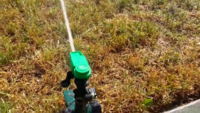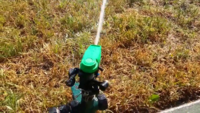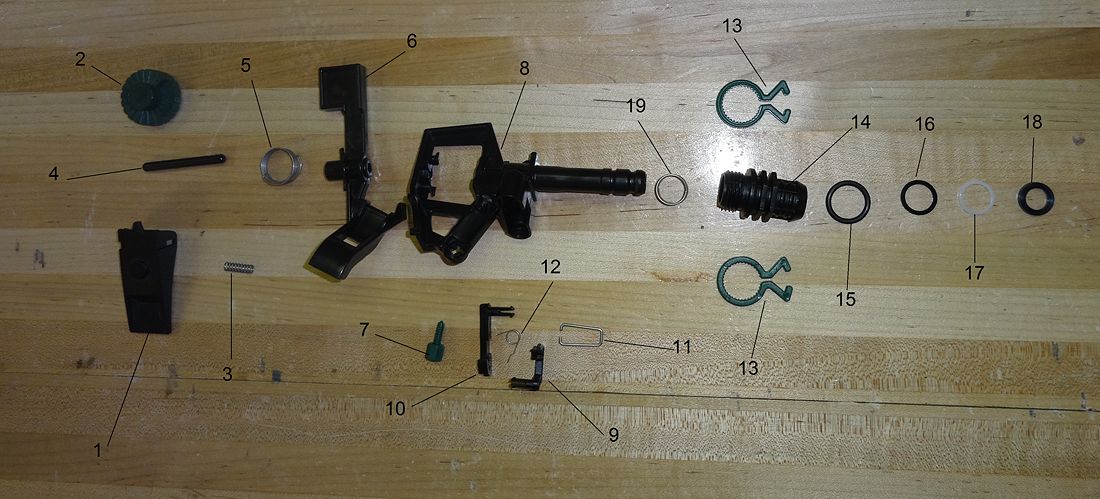Impulse sprinkler
From DDL Wiki
(→Part List) |
(→Executive Summary) |
||
| Line 2: | Line 2: | ||
| - | Our group chose to look at an impulse water sprinkler for our dissection. The specific name of the product is the Melnor Pulsator Sprinkler. After taking the product apart and researching its use and customers' reviews, we performed a Design For Manufacturing and Assembly (DFMA) analysis, Failure Mode and Effects (FMEA) analysis, and Design for the Environment (DFE) analysis. Upon completing our analysis, we decided upon a few different ways that the product could be improved. In the realm of DFMA, we thought that the method of mounting the sprinkler to a metal stake could be adjusted, as the current method requires many parts and much manual assembly. Additionally, we thought that with minor tweaking to the largest part, the Main Frame, the custom made screws and clips on the sprinkler could be purchased off the shelf. In the realm of FMEA, we found that the product was most likely to fail because of a fracture in the main frame (caused by mistreatment or cold weather), the system not being properly aligned for the mechanism that sends the sprinkler in reverse to function, or a clog in the nozzle. These problems could be fixed by making the sprinkler of a hardier material to stop fractures, adjust the lengths of the components in the mechanism that sends the sprinkler in reverse, and to put a diffuser into the nozzle to prevent material from getting in. A majority of the complaints against the sprinkler were that the mechanism that causes that causes the rotation eventually stops working. We suggest preventing this by using a stronger material (to prevent deformation that causes the failure) or by using a better method of mounting the spring that can break due to mishandling. Finally, in the DFE realm, we found the greatest improvement could be made in the packaging. The sprinkler itself had little obvious room for improvement, but they were sold in pairs with large metal spikes. The packaging itself had a lot of room for recycling information or proper water conservation techniques, but it was not there. Additionally, by not selling them with the spikes, you could encourage users to reuse older spikes rather than tossing them out. Judging by the short lifespan on the product (around | + | Our group chose to look at an impulse water sprinkler for our dissection. The specific name of the product is the Melnor Pulsator Sprinkler. After taking the product apart and researching its use and customers' reviews, we performed a Design For Manufacturing and Assembly (DFMA) analysis, Failure Mode and Effects (FMEA) analysis, and Design for the Environment (DFE) analysis. Upon completing our analysis, we decided upon a few different ways that the product could be improved. In the realm of DFMA, we thought that the method of mounting the sprinkler to a metal stake could be adjusted, as the current method requires many parts and much manual assembly. Additionally, we thought that with minor tweaking to the largest part, the Main Frame, the custom made screws and clips on the sprinkler could be purchased off the shelf. In the realm of FMEA, we found that the product was most likely to fail because of a fracture in the main frame (caused by mistreatment or cold weather), the system not being properly aligned for the mechanism that sends the sprinkler in reverse to function, or a clog in the nozzle. These problems could be fixed by making the sprinkler of a hardier material to stop fractures, adjust the lengths of the components in the mechanism that sends the sprinkler in reverse, and to put a diffuser into the nozzle to prevent material from getting in. A majority of the complaints against the sprinkler were that the mechanism that causes that causes the rotation eventually stops working. We suggest preventing this by using a stronger material (to prevent deformation that causes the failure) or by using a better method of mounting the spring that can break due to mishandling. Finally, in the DFE realm, we found the greatest improvement could be made in the packaging. The sprinkler itself had little obvious room for improvement, but they were sold in pairs with large metal spikes. The packaging itself had a lot of room for recycling information or proper water conservation techniques, but it was not there. Additionally, by not selling them with the spikes, you could encourage users to reuse older spikes rather than tossing them out. Judging by the short lifespan on the product (around two years) a person could easily acquire plenty of metal spikes they don’t need that required effort to produce. |
==Stakeholder Needs== | ==Stakeholder Needs== | ||
Revision as of 11:29, 3 February 2014
Contents |
Executive Summary
Our group chose to look at an impulse water sprinkler for our dissection. The specific name of the product is the Melnor Pulsator Sprinkler. After taking the product apart and researching its use and customers' reviews, we performed a Design For Manufacturing and Assembly (DFMA) analysis, Failure Mode and Effects (FMEA) analysis, and Design for the Environment (DFE) analysis. Upon completing our analysis, we decided upon a few different ways that the product could be improved. In the realm of DFMA, we thought that the method of mounting the sprinkler to a metal stake could be adjusted, as the current method requires many parts and much manual assembly. Additionally, we thought that with minor tweaking to the largest part, the Main Frame, the custom made screws and clips on the sprinkler could be purchased off the shelf. In the realm of FMEA, we found that the product was most likely to fail because of a fracture in the main frame (caused by mistreatment or cold weather), the system not being properly aligned for the mechanism that sends the sprinkler in reverse to function, or a clog in the nozzle. These problems could be fixed by making the sprinkler of a hardier material to stop fractures, adjust the lengths of the components in the mechanism that sends the sprinkler in reverse, and to put a diffuser into the nozzle to prevent material from getting in. A majority of the complaints against the sprinkler were that the mechanism that causes that causes the rotation eventually stops working. We suggest preventing this by using a stronger material (to prevent deformation that causes the failure) or by using a better method of mounting the spring that can break due to mishandling. Finally, in the DFE realm, we found the greatest improvement could be made in the packaging. The sprinkler itself had little obvious room for improvement, but they were sold in pairs with large metal spikes. The packaging itself had a lot of room for recycling information or proper water conservation techniques, but it was not there. Additionally, by not selling them with the spikes, you could encourage users to reuse older spikes rather than tossing them out. Judging by the short lifespan on the product (around two years) a person could easily acquire plenty of metal spikes they don’t need that required effort to produce.
Stakeholder Needs
- What does the user need?
- The user needs it to be easy to set up. It has to be easy to screw in to a hose without an excessive amount of water leakage.
- There have to be easy to follow instructions.
- It has to be portable, so that people with larger gardens can easily move it around.
- It has to be durable since sometimes people just leave it in their yard.
- It has to be reliable because the water distribution should be uniform.
- It has to be able to water the lawn effectively while minimizing the amount of water that ends up on the sidewalk or driveway.
- It has to work well with different water pressures.
- It has to be easy to clean and maintain.
- What does the retailer need?
- Inexpensive to produce and therefore inexpensive to acquire.
- Lightweight so it is easy to ship.
- Easy to explain to customers.
- Durable, so customers will not need warranty replacements or repairs.
- Compatibility with various mounts from various manufacturers.
- What does the manufacturer need?
- Inexpensive to purchase materials
- Inexpensive to create the pieces from the materials
- Simple assembly to keep assembly costs down
- Made of nontoxic materials (or have few toxic wastes) to save costs in preventative measures to protect workers or the environment
- Design capable of having schematics clear enough for foremen to understand what needs to be made
- Finished product not need to be maintained in any way to keep storage costs down while waiting for transport
- What does the transporter need?
- Durable enough to not break during rough handling
- Light enough to not over-encumber people or vehicles in the transportation sector
- Compact enough to fit plenty into small spaces (maybe they interlock to be smaller and more can be fit in trucks or boxes)
- Be able to withstand a variable range of temperatures likely to be experienced in transit
- Inexpensive so that should they be broken in transit, there is less monetary loss
- What does the product have?
- The product is easy to set up. All the user has to do is attach the sprinkler to the stake and put the stake in the ground and attach a hose
- It can be adjusted to cover 360° or to just spray a specific region.
- It has a sturdy build, but it has some plastic parts that may be prone to damage
- It has maintenance and cleaning instructions included in the packaging.
- Comments/Observations
A stake is not always required since some places are equipped with an underground pipe system which the sprinkler can be directly screwed into. The maintenance instructions are easy to follow; furthermore, there is a clever color code: all the things that need to be adjusted are in green.
Steps to using the product
Step 1: Remove from packaging
The sprinkler is tied into a cardboard sheet using plastic ties, which are easily cut.
Step 2: Make adjustments
The sprinkler head can be adjusted for the spray made, by using the built in deflector at the top or adjusting the diffusion of the spray. Furthermore, the plastic tabs at the bottom can be used to determine the angle of the spray, and can be restricted to a straight line or opened up to a 360° distribution.
Step 3:Stick the stake into the ground
Make sure the stake is deep enough that the water pressure won’t displace the sprinkler(picture from Amazon[2] since we couldn't actually test it because of the weather)
Step 4: Turn on Water Flow
Attach a hose to the open end on the stake, and turn on the water. The water pressure can be adjusted from the hose to affect the spray distance, as well as the knob on the top of the sprinkler
How the Product Works Mechanically
The water coming out of the nozzle goes into a S-shaped pipe from which the water goes out in the same direction it went in, but further to the left, allowing a higher torque to be generated. The reactive force to this torque is given by the acceleration of the inertia mass, such that the main frame remains almost immobile. When it then comes back toward the frame because of the spring and hits it, it gives its momentum to the main frame, which rotates a bit. But as it hits the frame, some water goes into the S-shaped pipe and the process begins again. If the spray arc is set to a 360 degree rotation, this rotation will continue indefinitely. However, if the spray arc is set to a limited range of motion, the metal bracket will trip on the clip after a few rotations, which will raise the interrupter. The interrupter stops the arm from rotating, so the force imparted to the S-shaped pipe is transferred back to the arm, and the rotation is reversed. While the first set of rotations described is choppy, with a small displacement each time the arm hits the main frame, this rotation is continuous. Eventually, the sprinkler will rotate back to its original position, where the metal bracket will hit the clip and lower the interrupter, and the process starts all over.
There are three different settings of the water spray that user input can affect. The first is how diffuse the spray is. The diffusion of the spray is controlled by the diffuser pin, which is the green screw seen in the picture above. If the screw is screwed in all the way, the water stream from the nozzle will hit the screw, causing the spray to diffuse. If the screw is unscrewed, the water stream will be uninterrupted, providing a more focused flow of water.
The second setting that can be adjusted is the distance of the spray. This is affected by the green adjuster knob at the top, which controls the slope of the distance adjuster. The water stream from the nozzle, after potentially hitting the diffuser pin, the hits the distance adjuster. At low distance settings, the distance adjuster is flatter, causing the water stream to deflect off it at a lower angle, and reducing the distance of the spray. At high distance settings, the distance adjuster becomes steeper, causing the water stream to come off at a higher angle, and increasing the distance of the spray.
The third setting that can be adjusted by the user is the angle of the spray, with two different modes. The two different modes (360 continuous/back and forth) are selected thanks to a lever, which can put a small plastic piece up or down each times it hits the metal parts setting the limits. When this piece of plastic is down, then the inertia mass will hit the main frame on it way back, pushing it counter-clockwise; when it is down, the inertia mass will hit the main frame before, just after being moved by the water going out of the s-shaped pipe, pushing it clockwise. That way you can go back and forth between two limits.
Videos testing a very similar model, from Rain Bird; between 04:00 and 05:30 on YouTube [3] Snapshots:
Part List
The impulse sprinkler examined consists of 19 parts, with 10 pieces being manufactured and 9 purchased off the shelf. The 10 manufactured pieces were all made of plastic, and produced via injection mold, while the off the shelf pieces consisted of 1 metal bracket, 4 metal springs, 3 rubber o-rings, and 1 Teflon ring. Part 13 (Clip), was used twice in the assembly, while each other part was used only once. There were no sub-assemblies identified in the product. The three parts that had to do with user adjustable settings were colored green, while all other plastic parts were made black.
Exploded view
Bill of materials
| Part Number | Name | Quantity | Mass (g) | Function | Material | Manufacturing Process | Image |
|---|---|---|---|---|---|---|---|
| 1 | Distance Adjuster | 1 | 5 | Adjusts distance of water stream | Plastic | Injection | |
| 2 | High Adjuster Knob | 1 | 3 | Adjust the slope of part 1 | Plastic | Injection | |
| 3 | Axial Spring 1 | 1 | <1 | Keeps part 1 up | Metal | Off the shelf | |
| 4 | Axle | 1 | <1 | Allows the arm to rotate in the main frame | Plastic | Injection | |
| 5 | Torsional Spring 1 | 1 | 1 | Brings the arm back towards the main frame | Metal | Off the shelf | |
| 6 | Arm | 1 | 13 | Inertia wheel/ Moves when hit by water and rotates the whole sprinkler when hit the frame | Plastic | Injection | |
| 7 | Screw | 1 | <1 | Disperses the water stream | Plastic | Injection | |
| 8 | Main Frame | 1 | 21 | Base of the assembly that all parts attach to; also has a hollow section for water flow. | Plastic | Injection | |
| 9 | Actuator | 1 | <1 | Triggers the direction lock | Plastic | Injection | |
| 10 | Interrupter | 1 | 1 | Changes the direction of rotation of the sprinkler | Plastic | Injection | |
| 11 | Metal Bracket | 1 | <1 | Hits the clips when it should change the direction of rotation and transmit the force to the actuator | Metal | Off the shelf | |
| 12 | Torsional Spring 2 | 1 | <1 | Connects part 9 and 10 as an unstable triggering system | Metal | Off the shelf | |
| 13 | Clips | 2 | 1.5 | Determine the range of motion | Plastic | Injection | |
| 14 | Mount | 1 | 6 | Connect to the hose and allows the frame to rotate | Plastic | Injection | |
| 15 | O-Ring 1 | 1 | <1 | Prevent leakage | Rubber | Off the shelf | |
| 16 | O-Ring 2 | 1 | <1 | Prevent leakage | Rubber | Off the shelf | |
| 17 | Ring | 1 | <1 | Allows the frame to rotate inside the mount by reducing friction | Teflon | Off the shelf | |
| 18 | O-Ring 3 | 1 | <1 | Holds the frame inside the mount and prevent leakage | Rubber | Off the shelf | |
| 19 | Axial Spring 2 | 1 | <1 | Push down the mount to prevent leakage | Metal | Off the shelf |
Design for Manufacture and Assembly (DFMA)
Design for Manufacturing
| Guideline | Properties in accordance with the guideline | Properties to improve |
|---|---|---|
| Minimize Part Count | The actuator & interruptor have clips
The axel is just jammed into the main frame The frame is injected in one piece | The spring of the height adjuster could be integrated (plastic)
There are many O-rings and a spring for the mount; could use another fixation method |
| Standarize Components | Springs, O-rings and clips are standarized
Sprinkler mount is standarized across different gardening tools | Could use off-the-shelf components for the diffuser screw and clips |
| Commonize Product Line | No specialized skills required to produce
→ mostly injection molded → don't need parts from other factories | |
| Standarize Design Features | Mount has standarized screw in | Uses a lot of different types of O-rings |
| Keep Designs Simple | Only three main pieces (frame, arm and mount) | |
| Multifonctional Parts | Arm diffuse spray & turns | Combine diffuser screw & height adjuster |
| Ease of fabrication | Everything is in plastic, injected | |
| Avoid High Tolerances | There is almost no tight tolerances needed | |
| Minimize Secondary & Finishing Operations | None! Settings are made by user | |
| Take advantage of Special Process Properties | Adjustable parts are green (color in injection molding) |
Design for Assembly
Numerous points (minimize Part Count, etc...) come both in DFM and DFA, so we will just add properties specific to the assembly in this table:
| Guideline | Properties in accordance with the guideline | Properties to improve |
|---|---|---|
| Mistake-Proof | Each part has a defined function and is unique (but for the two clips)
Frame is a single part Easy visual shape/control No screws | The two rotational springs are a bit difficult to put in place |
| Minimize Fasteners | Actuator/interrupter snap fits
Clips Height adjuster snap fits Axle is pressed in | Mount system could be simplified |
| Minimize Handling | Everything is built around a central axis
Everything can be done with bare hands, except for actuator/interruptor/spring system (but with very basic tools) | |
| Minimize Assembly Direction | Fill things into the frame | The actuator/interruptor system is not along this main axis |
| Provide Unobstructed Access | All parts can be seen, no hidden subassemblies | |
| Features in your product that have no functionality in the use phase but are there instead to support assembly | Mount hub spring |
Failure Mode and Effects Analysis (FMEA)
| Item and Function | Failure Mode | Effects of Failure | S | Causes of Failure | O | Design Controls | D | RPN | Recommended Actions |
|---|---|---|---|---|---|---|---|---|---|
| Bracket and Clips | Bracket will not trip on clips | Won't rotate | 4 | Clip is too high to trip bracket | 8 | None | 1 | 32 | Lower clip or make bracket longer |
| Bracket | Deformation | Won't be able to turn in full circle | 4 | Mishandling | 4 | None | 1 | 16 | Change material selection |
| O-ring system | Fracture, deformation, or improper assembly | Main body and mount will separate, causing main body to shoot upwards | 8 | Temperature and wear | 1 | Quality control | 1 | 8 | None |
| Mount spring | Deformation | Leakage and no rotation | 5 | Fatigue | 2 | None | 2 | 20 | Change mounting system or denser spring |
| Axial spring 2 | Become unattached or fracture | Won't rotate | 4 | Mishandling | 1 | Tabs to keep spring in place | 1 | 4 | Better way of mounting spring |
| Upper seal | Deformation | Leak | 4 | Extreme weather, fatigue, mishandling | 1 | None | 3 | 12 | Ensure material is durable |
| Upper seal | Seal becomes unattached | Leak | 3 | Mishandling, particularly while attaching and unattaching | 2 | Built ring to keep seal in place | 3 | 18 | None |
| Nozzle | Blockage | Improper water flow | 4 | Weather, mishandling | 4 | None | 2 | 32 | Could integrate diffuser into nozzle, could act as guard |
| Failure of interruptor/actuator assembly | Action disrupted | Interruptor may not function | 4 | Mishandling or other that causes dirt or other impediment in assembly | 3 | None | 2 | 24 | Design snap-on cover for mechanism |
| Failure of interruptor/actuator assembly | Spring disconnection | Interruptor may not function | 5 | Improper treatment or assembly | 2 | Quality Control | 1 | 10 | Design better way to attach spring or snap-on cover for mechanism |
| Pin/rod and main body | Fracture | Leak and possibly significant pressure loss at nozzle | 4 | Improper assembly or manufacturing variability | 1 | Post-assembly inspection | 3 | 12 | Quality control |
| Pin/rod and main body | Loss of part geometry | Improper alignment of arm and adjuster dial | 4 | Improper assembly or manufacturing variability | 1 | Post-assembly inspection | 2 | 8 | Quality control |
| Main body | Fracture | Leak | 4 | Mistreatment or use in cold weather | 5 | None | 2 | 40 | Different body material |
Design for the Environment (DFE)
Eco-Manufacturing Design
The biggest way that the product could be designed better as far as eco-manufacturing is concerned deals with the packaging. The packaging is a large sheet of cardboard and it holds the two sprinklers with plastic zip ties. There is so much blank space in the packaging that could be used for including more information about the sprinkler, such as maintenance and recycling instructions. Also, since the majority of the product is made of plastic, the manufacturer could look into using recycled plastics with similar properties to the plastic currently being used. The packaging included two large and heavy metal stakes, which accounts for the bulk of the shipping weight and is undesirable for consumers who don't want to make a hole in their lawn.
Our most interesting new concept was a Roomba-like machine that goes around a yard and delivers the correct amount of water to each section of the lawn. It will drastically reduce over- and under-watering of lawns and it will make sure that the lawn is watered evenly as well. It will be ideal for the small sections of grass along the sidewalk and it can also have a mechanism to evenly distribute fertilizer as well. It would require some electronic software so that it would be able to detect edges of lawns and to monitor the amount of water being distributed to the grass.
| DFE Guideline | Good Aspects of Competitor Product or Ideas for Improvement |
| 0. New Concept Development | Have in-ground sprinklers
Include lawn fertilizer in the spraying Have a sprinkler attached to a lawnmower Roomba-like sprinkler (mechanism crawls around yard to water grass) Have a stakeless stand |
| 1. Select Low Impact Materials | Use a non-metal stake
Use recycled plastic |
| 2. Reduce Material Amount | Lessen paper packaging
Make sprinklers fit together for smaller packaging size Use a lighter metal for the stake Have a stand that does not need to be driven into the ground |
| 3. Eco-Manufacturing | Use recycled plastic since there are already plastic pieces being used
Have a seasonal assembly line since sprinkler production is higher in the springtime |
| 4. Optimize Distribution | Reduce the amount of paper in packaging
If pieces can fit together, it will take up less space in boxes for shipping |
| 5. Reduce Use-Phase Impact | Include information on correct amount of water for a lawn
Reduce leakage |
| 6. Maximize the First Life | Use sturdier plastics
Include maintenance instructions with packaging Have simple ways to clean and maintain the sprinkler Make the metal bracket stronger and have the subassembly more durable |
| 7. End of Life | Provide recycling instructions in packaging
Use recyclable plastics Do not use glue/adhesives |
Economic Input-Output Life-Cycle Assessment (EIOLCA)
For EIOLCA on the impulse sprinkler, it turns out that there were only two input factors that were relevant. In the production phase, there was only one relevant product, the entire sprinkler assembly, falling under the sector "Other Plastics Products Manufacturing". In the use phase, the only thing consumer uses during operation is water, under the "Water, Sewage, and Other Systems" sector. Over the two year lifetime of the sprinkler, the total carbon dioxide tax from the sprinkler was $3.11.
A number of assumptions about the lawn and environment, as well as about sprinkler operation had to be made in order to perform EIOLCA. Water use will vary greatly depending on the type of grass and size of the lawn, as well as the number of weeks per year that the lawn will be watered. It was assumed that the lawn would require 1" of water per week, and the lawn was 1000 square feet in surface area. By using 1" of water and 1000 square feet, it makes it easier to recalculate the CO2 emissions, if given different lawn parameters. Furthermore, it was assumed that the lawn would be watered for 30 weeks of the year, with the other 22 weeks being in the late fall and winter months when it is too cold for grass to grow. Last, we had to assume that the sprinkler would spray the water uniformly over the desired area, and that leakage in the sprinkler was negligible, in order to calculate water use.
| Production Phase | Use Phase | |
|---|---|---|
| Sprinkler Manufacturing | Water | |
| Sector | #32619A: Other Plastics Product Manufacturing | #221300: Water, Sewage, and Other Systems |
| MTCO2E per $1M | 748 | 1780 |
| Unit | Sprinkler | 1000 Gallons |
| Units per Lifetime | 1 | 37.4 |
| Cost per Unit ($2002) | 5.00 | 1.50 |
| Lifetime Cost ($2002) | 5.00 | 56.1 |
| Implied mtCO2e | 0.004 | 0.100 |
| CO2 tax @ $30/mt | $0.11 | $2.99 |
| Assumptions | 2 year life | 1000 square foot lawn, 1 inch water per week, 30 weeks/year |
Team Roles
Team Leader: Tristan Greiner
DFMA Lead: Louis Dufour
FMEA Lead: William Bullard
DFE Lead (Eco-Manufacturing): Hira Ahmad
DFE Lead (Life-Cycle): Justin Hui Bon Hoa
Citations
[1] Home Depot Customer Reviews
[3] Impact Sprinklers Performance Review - Vigoro Vs. Rain Bird, by user Miguel Chavez

